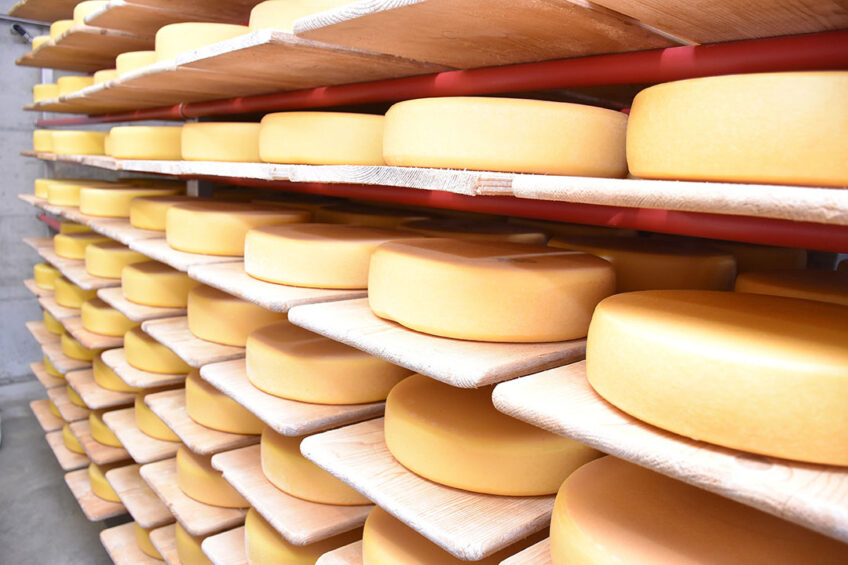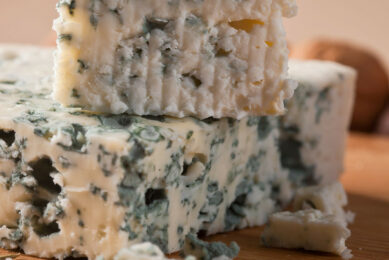Switzerland: Huge appetite for cheese

Making cheese is big business in Switzerland and is a real lifeline for many of the country’s dairy farmers who milk cows while conquering the challenges of the Swiss Alps.
Swiss people have a huge appetite for cheese, eating their way through an average 20 to 25kgs of the dairy product per person per year. The country produces around 185,000 tonnes of cheese annually into over 450 varieties, including the popular Emmentaler, Le Gruyere and Sbrinz brands, and imports another 58,000 tonnes to satisfy the population of 8.5 million people’s hunger for cheese.
Milking Brown Swiss
The most recent records state there are 22,000 dairy farms in Switzerland, with an average size of 18.6 hectares and home to 587,000 dairy cows producing 3.5 billion kilograms of milk per year. For 5 months of the year around 20% to 30% of dairy farmers milk their cows 1,200 metres up in the mountains before bringing the animals down to the lowland winter accommodation around the start of October. Relying on the strong desire for cheese in Switzerland, dairy farmers like Reto Theiler, his wife Silvia and 5 children, spend the summer months milking their herd of 50 Brown Swiss cows at 1,250m above sea level on the Abnistetten Alp near the village of Entlebuch. There had been no cheese produced at this farm since 1948 so back in 2011 Reto decided to replace a 260 year old barn with a new structure integrating cow housing, a cheese production facility, milking parlour and a living apartment for the family.

Shape, substance and flavour
Cows are milked twice a day in the 4 point abreast parlour and yield around 25 to 30kg of milk per day with 3.4% protein and 4.3% butterfat. Reto says: “All of the milk we produce goes into making cheese, butter and cream. It takes around 70 litres of milk to produce 6 kilograms of cheese. “We employ Thomas Hofstetter to look after all the milk and cheese production and my wife and I look after the marketing aspect. Our cows produce top quality milk grazed from the alpine meadows in the summer months but if it gets too hot we bring them indoors and feed them hay.” When produced, all the cheese is turned 5 to 6 times per day to give it shape, substance and flavour. Reto’s farm produces 4 varieties of hard and soft cheeses which they sell to private customers and retailers.
€ 0.52 per litre
“A lot of people buy the cheese from our farm shop when they are hiking in the mountains,” says Mr Theiler. “Up to 80% of our cheese is sold through 2 retail chains which pay us CHf12 Swiss francs (€ 10.45) per kilogram and sell it in their stores for CHf22 (€ 19.16) per kilogram. If customers buy it from our farm shop they pay CHf18 (€ 15.68) per kilogram for the cheese.” In comparison to fresh milk sales in Switzerland a farmer receives around CHf0.60 (€ 0.52) per litre for ordinary commercial milk but those milking cows in the Alps receive an extra CHf0.18 (€ 0.16) per litre from the government. Incidentally, selling cheese for CHf12 per kilogram is the equivalent of receiving CHf0.90 (€ 0.78) for one litre of milk. Delving deeper into subsidies, a dairy farmer receives CHf330 (€ 287.40) per cow if they are grazed for over 100 days in the summer time. A farmer in the Alps receives an additional CHf400 (€ 348.37) per cow for farming in a difficult terrain. Mr Theiler says he is very satisfied with life as a dairy farmer and does not want to be trapped in the European Union style of farming. “Consumers appreciate the work we farmers do in providing food,” he says. “We have a decent family lifestyle with 5 months spent up in the Alps and 7 in our lowland farm. Our government also supports us well and with the huge appetite for cheese in Switzerland we can generate a decent income each year. However, it’s not all so positive as we do farm in difficult conditions in the mountains and rely on making good tasty and saleable cheese to survive,” he adds.

Winter period
When the summer grazing period in the Alps is over Mr Theiler takes his cows to his lowland farm for the winter where they are kept in a tie-stall barn. “We have 40 hectares in the Alps and rent a further 20 hectares for the young stock. There are another 30 hectares owned in the lowland farm which is normally used for hay and silage production to feed the cattle during the cold winter. During the winter period we produce commercial liquid milk and receive the CHf0.60 per litre for it. I am somewhat concerned about the price and whether it will stay at that level. Switzerland does import a lot of cheaper cheese into the country and a lot of people travel across the Swiss border to do their shopping for less money,” he concludes.
Join 13,000+ subscribers
Subscribe to our newsletter to stay updated about all the need-to-know content in the dairy sector, two times a week.










